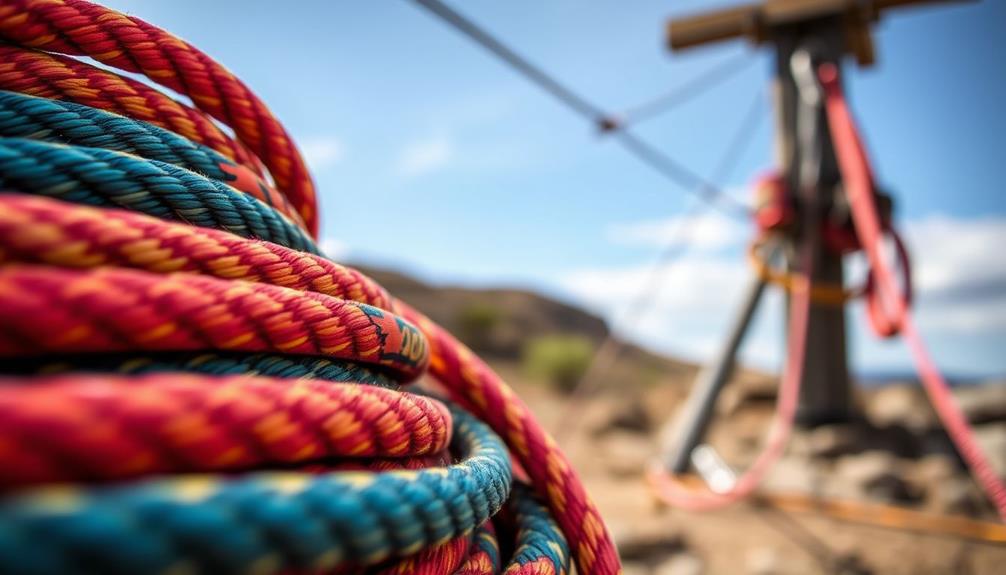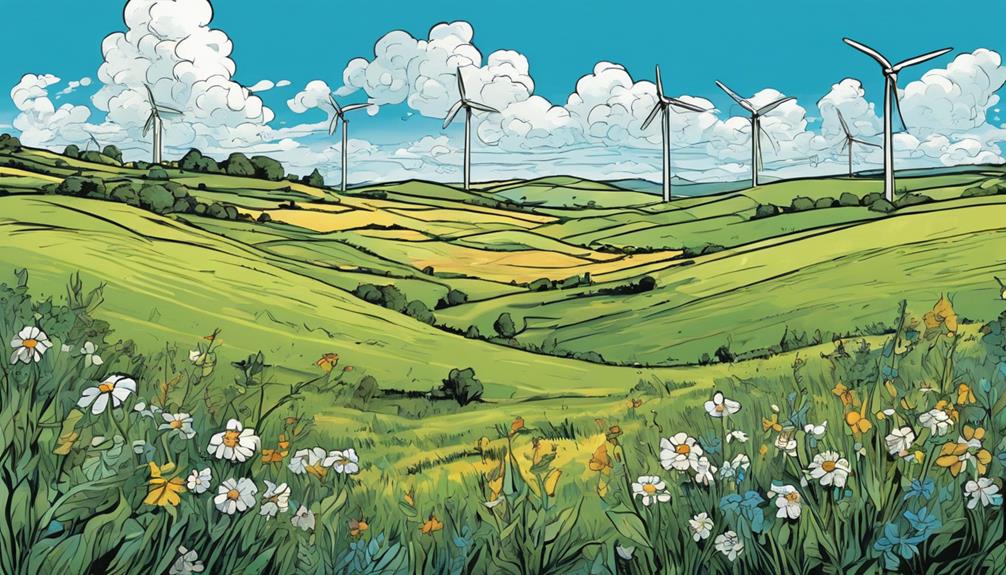Windmill blades typically average about 210 feet long, but some models, like the GE Haliade-X, can reach up to 351 feet. This increase in size reflects advancements in technology and design aimed at capturing more energy from the wind. In fact, the average rotor diameter of new turbines has soared to over 438 feet in 2023, and many blades now exceed 380 feet. Larger blades enhance power capacity by increasing the wind-swept area, allowing for greater energy output. If you're curious about the ongoing innovations in wind energy, there's much more to explore.
Key Takeaways
- The average wind turbine blade length is approximately 210 feet, with some advanced models like the GE Haliade-X reaching 351 feet (107 meters).
- In 2023, the rotor diameter of newly installed U.S. wind turbines exceeded 438 feet, showcasing the rapid growth in blade size.
- New installations predominantly feature rotors of 115 meters (380 feet) or larger, reflecting a trend toward maximizing energy capture.
- Research is exploring theoretical blade lengths of up to 200 meters to further enhance efficiency and energy output.
- Larger blades significantly increase power capacity, with energy output potentially quadrupling when blade length is doubled.
Understanding Windmill Blade Sizes
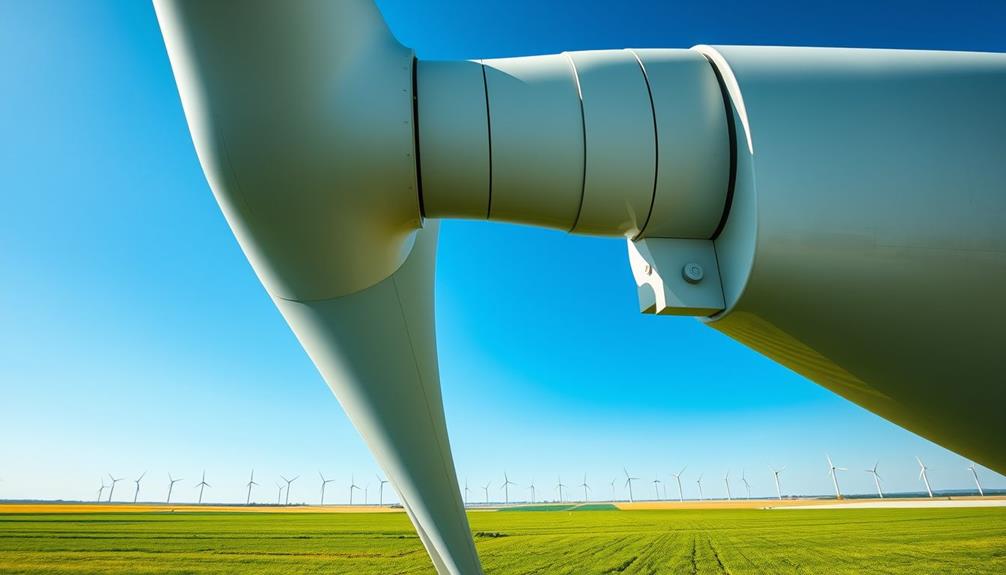
When it comes to windmill blade sizes, you'll find a remarkable range that considerably impacts energy production. Wind turbine blades typically average around 210 feet in length, but some, like the GE Haliade-X, soar to an impressive 351 feet. This increase in blade length considerably boosts the rotor diameter, which averaged over 133.8 meters (approximately 438 feet) in 2023.
Larger rotor diameters mean greater wind-swept areas, allowing for enhanced power generation capabilities and improved efficiency in electricity production from wind turbines.
Offshore wind turbines often boast even bigger blades compared to their onshore counterparts. In fact, some offshore blades can reach lengths that are more than half the height of the turbine tower, maximizing energy capture from the wind.
The evolution of blade length has been extraordinary, with rotor swept areas expanding by about 670% since 1998-1999. This advancement not only improves efficiency but also contributes to impressive power outputs; just one rotation of the largest turbines can provide electricity to a home for two days.
Understanding these sizes helps you appreciate the engineering behind wind energy and its growing role in sustainable power production.
Hub Height and Its Impact
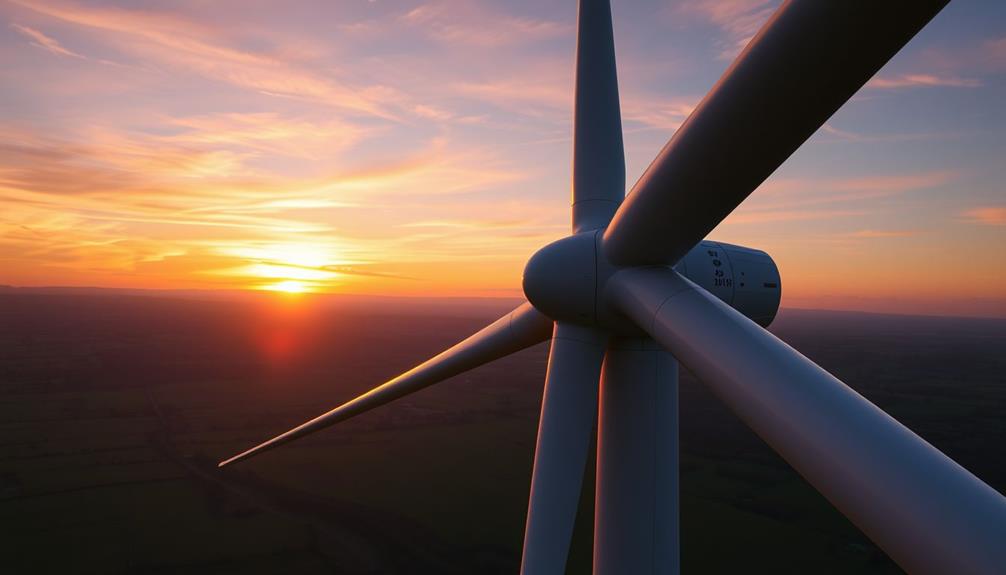
Hub height plays an essential role in the efficiency of wind turbines, as it measures the distance from the ground to the rotor's center. In 2023, utility-scale land-based turbines boast an average hub height of 103.4 meters (about 339 feet), marking an 83% increase since 1998-1999.
Taller wind turbines are strategically placed in areas like the Midwest and Northeast, where higher wind shear allows for better energy harvesting. This trend towards taller turbines mirrors the diversification strategies seen in other investment sectors, such as the benefits of rolling over to a Gold IRA for enhanced financial security.
By increasing hub height, you enable turbines to access stronger and more consistent winds at greater altitudes. This translates to improved energy production since these higher wind speeds can considerably enhance the amount of electricity generated.
Offshore wind turbine hub heights are projected to rise from 100 meters (330 feet) in 2016 to 150 meters (500 feet) by 2035, further optimizing energy capture.
The trend toward taller turbines is part of a broader shift in turbine technology. This advancement not only allows for larger installations but also increases efficiency and capacity, making renewable energy more viable than ever.
Embracing these developments means a brighter future powered by wind energy.
Rotor Diameter Explained

Rotor Diameter Explained
Taller wind turbines aren't just about hub height; rotor diameter plays a pivotal role in maximizing energy capture. In 2023, the average rotor diameter of new wind turbines in the U.S. reached an impressive 133.8 meters (approximately 438 feet). This shift towards larger turbines isn't just a trend; it's a necessity for increasing wind energy capacity.
With 98% of new installations featuring rotors of 115 meters (380 feet) or larger, the industry is clearly moving in one direction—bigger is better. The growing popularity of renewable energy sources, such as wind power, mirrors trends seen in other sectors, like building tiny homes, where efficiency and sustainability are key considerations.
Larger rotor diameters allow turbines to sweep more area, enhancing their ability to capture wind energy. This increase in swept area has surged by about 670% since 1998-1999, thanks to advancements in turbine technology and design.
The relationship between rotor diameter and energy output is significant; doubling the blade length can boost power capacity by a factor of four. By investing in larger turbines, you're not just improving efficiency; you're maximizing the potential of wind energy to meet growing demands.
Understanding rotor diameter's impact is essential for anyone interested in the future of renewable energy.
Nameplate Capacity Trends
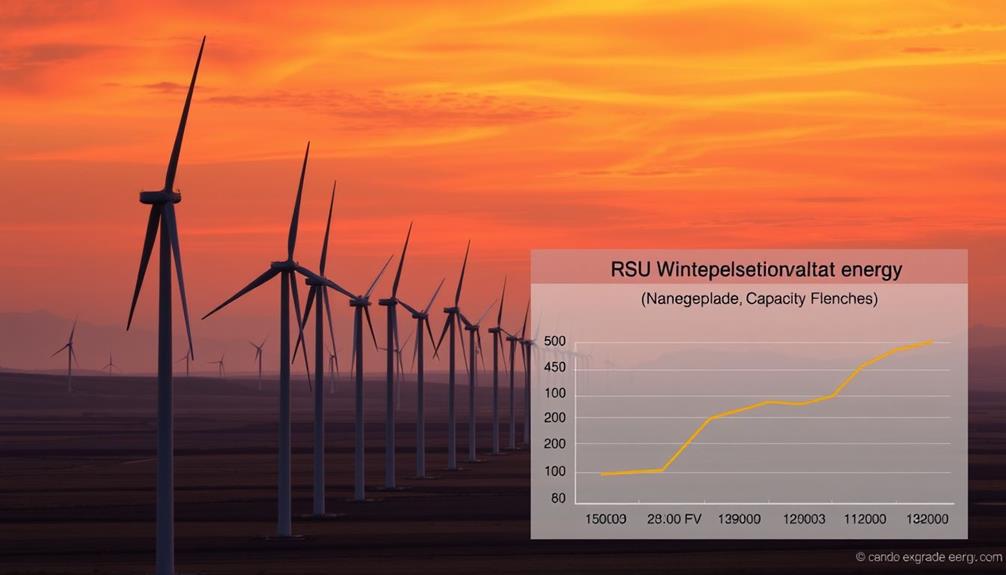
You might've noticed that the average nameplate capacity of newly installed U.S. wind turbines has steadily increased over the years, reaching 3.4 megawatts in 2023.
This rise in capacity not only helps meet growing energy demands but also enables fewer turbines to produce the same amount of energy.
As investment strategies evolve, advancements in technology and policy changes are shaping the future of wind energy, making it a more viable option for sustainable growth.
As we explore these trends, you'll see how advancements in technology and policy changes are shaping the future of wind energy.
Capacity Increase Over Time
The evolution of wind turbine nameplate capacity over time highlights significant advancements in technology and efficiency. In 2023, the average nameplate capacity of newly installed wind turbines in the U.S. reached 3.4 megawatts (MW), marking a 5% increase from the previous year and a staggering 375% increase since 1998-1999.
This capacity increase reflects the industry's shift toward larger and more efficient models, with a notable rise in turbines boasting capacities of 3.5 MW or greater. Sector performance metrics play an essential role in understanding these advancements, as they help investors evaluate the potential returns from renewable energy investments.
As you consider the implications of these trends, it's clear that higher capacity wind turbines enable fewer units to generate the same amount of renewable energy. This reduction not only streamlines the installation process but also lowers overall costs associated with wind energy production.
Since the early 2000s, technological advancements have continuously improved turbine efficiency and output, allowing the sector to meet the growing demand for wind energy. With projections indicating a need for an additional 10,000 turbines over the next two decades, ongoing enhancements in capacity will be vital for sustaining this momentum and supporting the renewable energy evolution.
Impact on Energy Production
Increasing nameplate capacities in wind turbines considerably impact energy production, allowing for more efficient generation of renewable energy. In 2023, the average nameplate capacity of newly installed U.S. wind turbines reached 3.4 megawatts (MW), a staggering 375% increase since 1998-1999. This shift reflects a growing trend towards turbines with capacities of 3.5 MW or larger, making your investment in wind energy even more impactful.
As the demand for renewable energy sources rises, the role of AI Software Engineer Jobs becomes essential in optimizing turbine performance and efficiency.
With larger nameplate capacities, you can rely on fewer turbines to generate the same amount of energy, which ultimately reduces overall costs for wind energy production. The advancements in turbine technology don't stop there; the average rotor diameter has also increased, exceeding 133.8 meters (approximately 438 feet) in 2023. These larger blades capture more wind, enhancing energy production efficiency and harnessing wind energy like never before.
This growth in nameplate capacity is driven by ongoing research and development, alongside favorable changes in production tax credits.
As the landscape of wind energy evolves, you can expect even more significant advancements that will further optimize energy production and solidify wind energy's role in a sustainable future.
Transportation and Installation Challenges
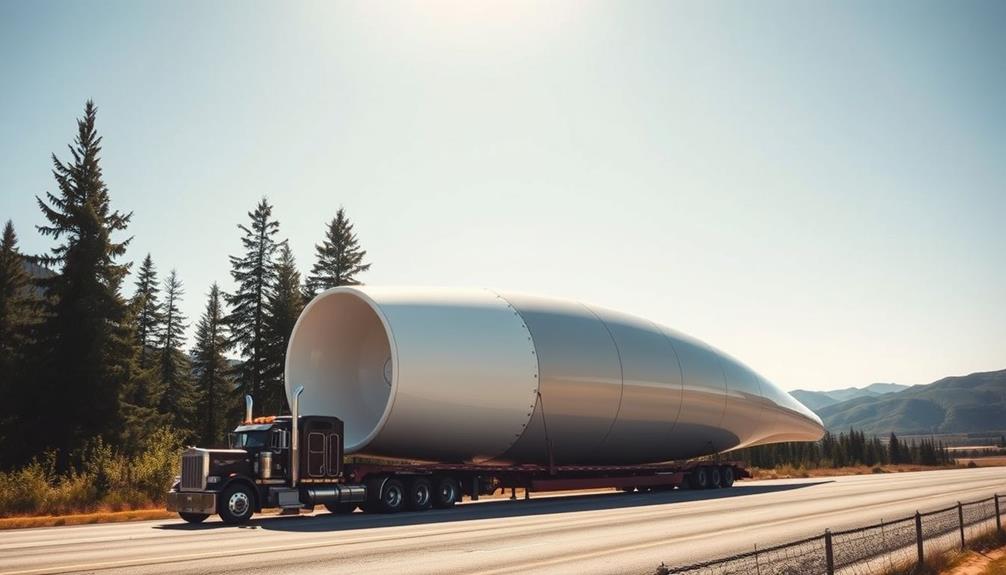
Transporting wind turbine blades isn't as simple as it sounds.
You'll face route limitations due to their oversized nature, which can restrict access to certain roads and bridges.
Additionally, understanding the mechanics of different brewing methods can be essential when planning logistics for transporting large components.
Plus, installing these massive components requires specialized equipment to guarantee everything goes smoothly.
Transport Route Limitations
Maneuvering the transport of oversized wind turbine blades poses considerable challenges due to their immense size, often exceeding 107 meters (over 350 feet) in length.
These massive turbine blades can't be folded, which greatly restricts your transport route options. You need to carefully plan for traversing through various infrastructures, ensuring that the blades can fit under bridges and highway overpasses. This complexity mirrors the iterative prototyping and testing processes seen in design thinking methodologies, which emphasize creative problem-solving tailored to user needs.
Logistics becomes a complex puzzle, especially when transporting large turbine components across different terrains. You'll quickly realize that the average costs can skyrocket—short-haul transport typically runs between $30,000 to $40,000 per turbine, while long-haul shipments can exceed $100,000.
Additionally, route planning for oversized shipments must comply with state regulations, which often means obtaining special permits and coordinating escort services. These transport route limitations can complicate logistics, as average blade lengths and weights require meticulous planning to avoid delays.
To address these challenges, the Department of Energy is exploring innovative solutions, such as slender and flexible blades, which could make traversing roads easier and streamline the transportation process for large wind turbine components.
Installation Equipment Requirements
The complexities of transporting oversized turbine blades naturally extend into the installation phase, where specialized equipment is crucial for successful setup. As turbine sizes grow, the logistical complexities become apparent.
You'll need to navigate state regulations and infrastructural constraints while ensuring safe delivery and installation. That's no small feat! Additionally, similar to the challenges faced in home security systems, the presence of effective planning and execution can greatly enhance safety during transportation and installation processes increased safety and peace of mind.
Consider these emotional challenges:
- High costs: Short-haul transport can set you back $30,000 to $40,000, while long-haul shipments may exceed $100,000.
- Route planning: You must carefully chart paths around bridges and highway overpasses to accommodate oversized shipments.
- Disassembly requirements: Sometimes, parts need to be disassembled for transport, adding another layer of complexity.
- Specialized trailers: Using multi-axle trailers is crucial to support the considerable length and weight of turbine blades, averaging 210 feet or 107 meters.
To tackle these challenges, companies like Keystone Power Systems and GE Renewables are developing innovative solutions.
The Department of Energy is also exploring slender and flexible blade designs, which could ease transportation and installation difficulties in the future.
Blade Size Evolution
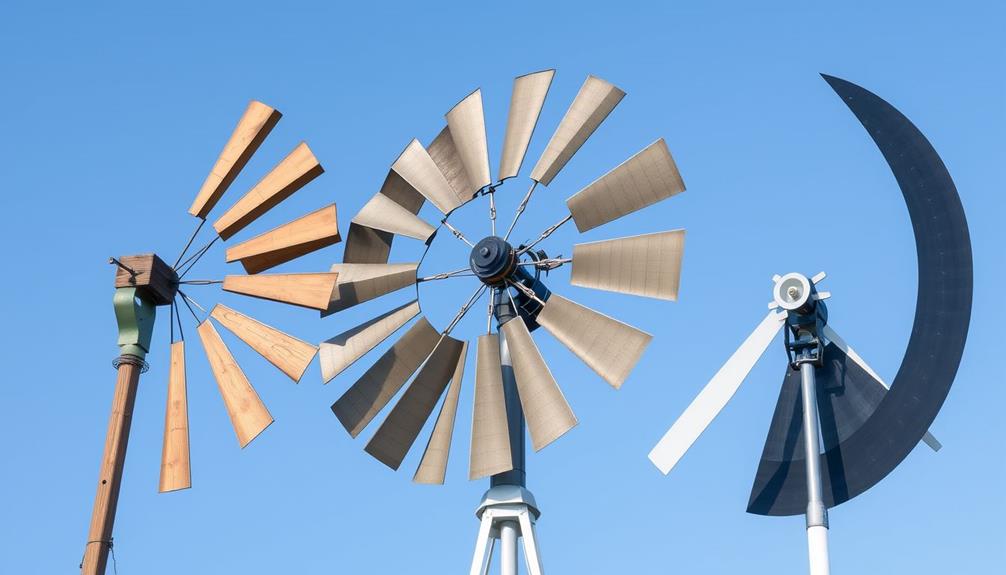
Wind turbine blades have undergone a remarkable transformation over the years, evolving in size and efficiency to harness more energy from the wind. The average rotor diameter of newly installed wind turbines in the U.S. reached over 133.8 meters (approximately 438 feet) in 2023, a considerable leap from earlier models. By 2023, 98% of new installations featured rotors of 115 meters (380 feet) or larger, showcasing the rapid blade size evolution.
Here's a closer look at the rotor diameters over the years:
| Year | Average Rotor Diameter | Key Model |
|---|---|---|
| 2013 | Under 115 meters | Early Generation Models |
| 2020 | Over 130 meters | Modern Wind Turbines |
| 2023 | Over 133.8 meters | GE Haliade-X (107m blades) |
The advancements in blade lengths have allowed for a rotor swept area expansion of approximately 670% since 1998-1999, considerably enhancing energy capture. Current innovations are even exploring theoretical blade lengths of up to 200 meters, indicating that the future of wind turbines is poised for even greater efficiency.
Why Are the Blades Larger?
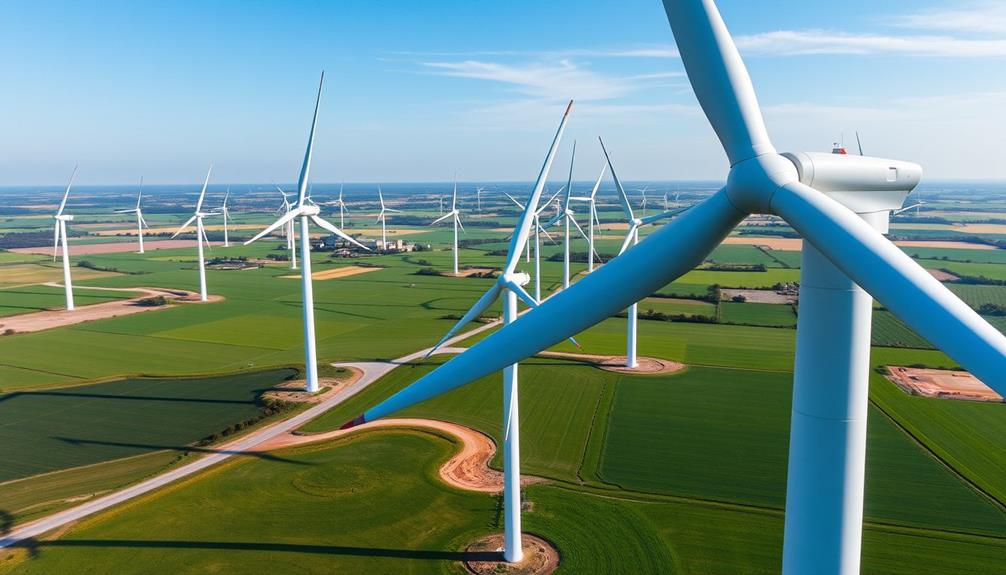
As blades have grown in size, the reasons behind this trend become clear. Larger wind turbine blades markedly enhance power capacity by increasing the wind-swept area. When you double the length of these blades, you can actually increase energy output by a factor of four. This means that each rotation captures more wind energy, translating into more electricity generated.
The shift towards larger blades reflects a deeper understanding of philosophical exploration regarding sustainability and innovation in energy solutions. The move towards larger blades isn't just about performance; it's also about efficiency and sustainability.
Here are a few emotional factors driving this change:
- � Harnessing clean energy for a sustainable future
- � Lower costs through economies of scale
- ⚡ Reduced material usage while maximizing output
- � Embracing innovation to combat climate change
As of 2023, the average rotor diameter of new wind turbines in the U.S. surpassed 133.8 meters, showcasing a clear trend toward larger blades. The GE Haliade-X turbine, with blades measuring 107 meters, is comparable in length to a football field, highlighting the impressive scale of modern wind energy technology.
The Largest Turbine Blades
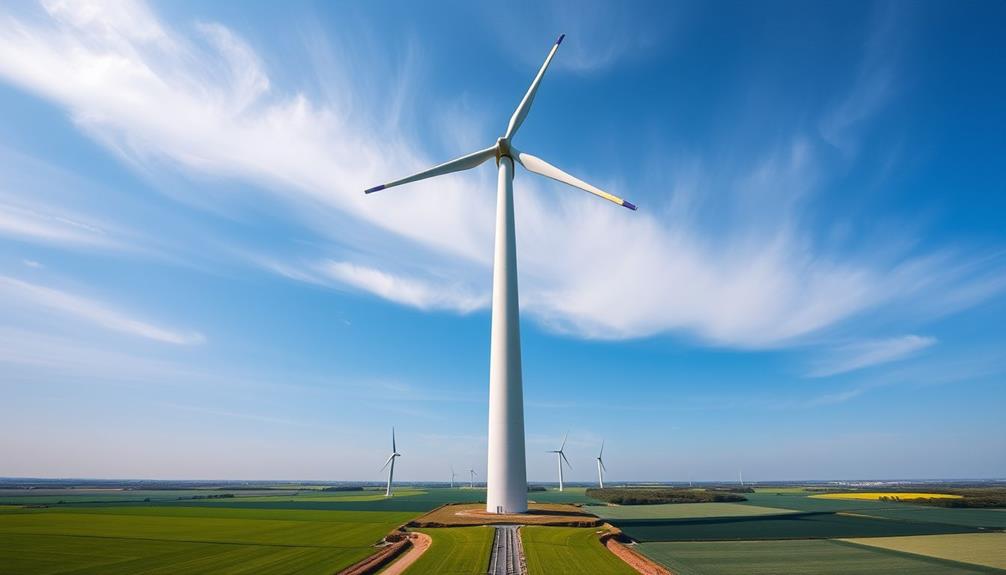
At an impressive 107 meters (351 feet) in length, the GE Haliade-X turbine blades stand as a demonstration to the advancements in wind energy technology. These are the largest turbine blades currently in operation, designed for a turbine with a capacity of 12-14 megawatts. This makes the Haliade-X one of the most powerful offshore wind turbines available today.
With a rotor diameter of 220 meters (722 feet), the blades represent over 80% of the tower height, which reaches 248 meters (814 feet). This significant size plays a vital role in capturing wind power more efficiently. In fact, as of 2023, the average rotor diameter of new turbines in the U.S. has surpassed 133.8 meters (438 feet), highlighting a trend toward larger blades.
Over the past decade, the size of wind turbine blades has increased by approximately 670% since 1998-1999. This growth reflects ongoing advancements in technology and design, all aimed at maximizing energy production and efficiency.
Your understanding of turbine size can help appreciate the scale of innovation in the renewable energy sector.
Limits of Blade Size
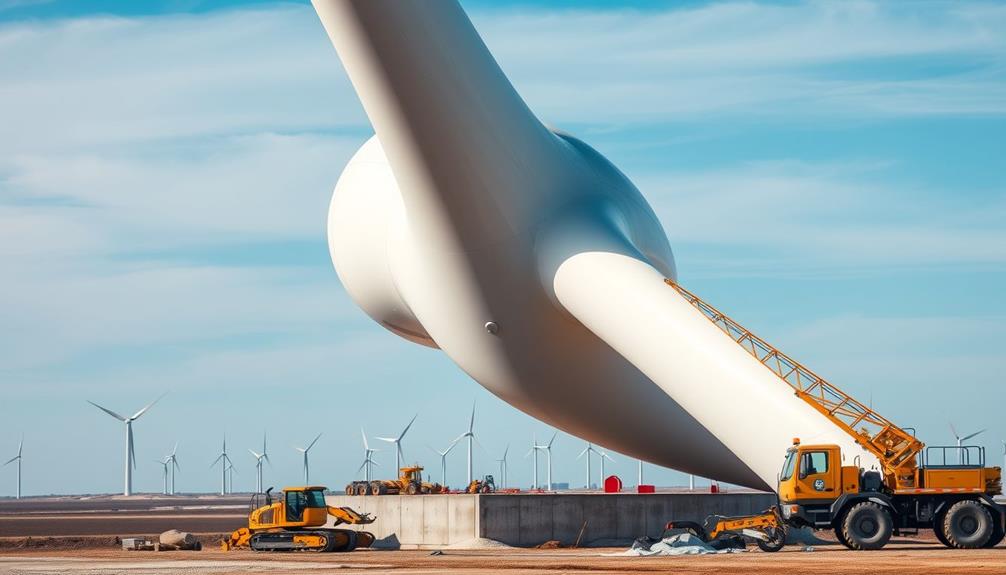
The challenge of maximizing wind turbine blade size lies in balancing ambition with practical limitations. While the GE Haliade-X features impressive 107-meter blades, the pursuit of even larger designs, like the theoretical 20 MW UpWind Project with blades reaching 123 meters, highlights the ongoing quest for innovation.
However, achieving these goals means grappling with critical factors that can't be ignored.
- The risk of structural integrity failures as blades grow longer
- Operational safety concerns during extreme weather events
- Collision hazards with the turbine tower as height increases
- The potential impact on surrounding wildlife and ecosystems
Each factor plays a pivotal role in determining how far we can push blade length. As the blades increase in size, they face bending and flexing challenges that threaten their durability.
In addition, ensuring that turbines can withstand harsh weather conditions without compromising safety is essential. While we can dream of 200-meter blades for a future 50 MW turbine, these ambitious designs remain largely untested.
Ultimately, the limits of blade size remind us that innovation must work hand-in-hand with safety and reliability in our renewable energy journey.
Future of Wind Energy Technology
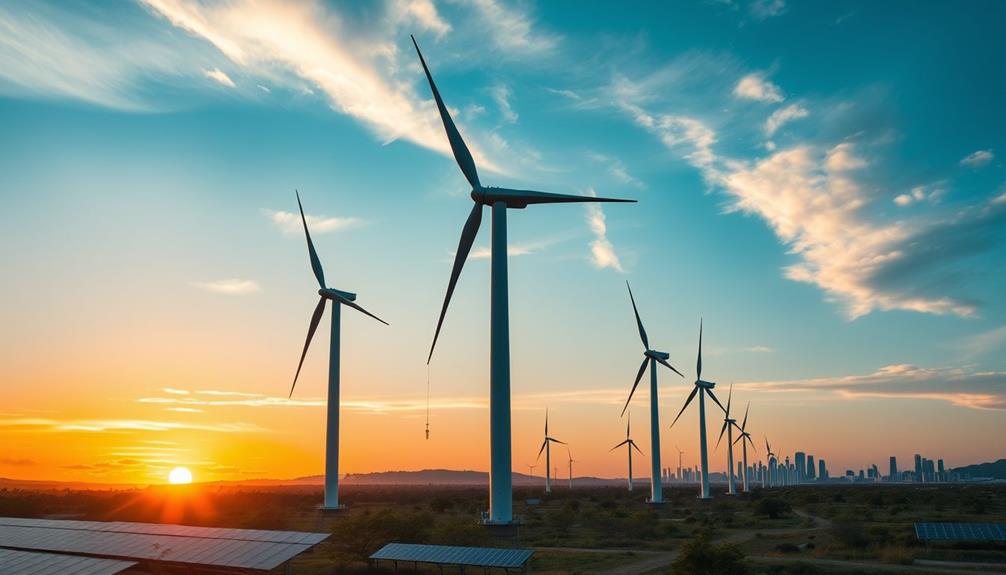
Exciting advancements are on the horizon for wind energy technology, promising to reshape how we harness renewable resources. In 2023, the average rotor diameter of newly installed wind turbines soared to over 133.8 meters, allowing you to capture more wind energy and greatly boost energy generation.
With offshore wind turbine hub heights projected to reach 150 meters by 2035, you'll access stronger winds, enhancing overall efficiency.
The average capacity of new U.S. wind turbines now stands at 3.4 megawatts, a remarkable 375% increase since 1998-1999, thanks to ongoing innovations in turbine technology. Researchers are also exploring slender and flexible wind turbine blades, which could ease transportation challenges tied to larger components.
These innovations aim to enhance not just efficiency, but also the sustainability of wind energy, addressing environmental concerns while meeting energy generation needs.
As turbine design and materials evolve, you'll see a future where wind energy plays an even more vital role in our energy landscape. Embracing these advancements could lead you toward a cleaner, more sustainable energy future.
Frequently Asked Questions
How Long Are the Blades on Energy Windmills?
You'll find that windmill blades vary in length, typically averaging around 210 feet. Some advanced models, like the GE Haliade-X, boast blades over 350 feet, optimizing energy capture and enhancing overall power generation efficiency.
How Does the Length of the Wind Turbine Blades Affect the Energy Output?
Imagine a giant bird soaring high; the longer its wings, the farther it glides. Similarly, longer wind turbine blades capture more wind, greatly boosting energy output and transforming breezes into powerful, sustainable electricity for your needs.
How Long Is One Blade of a Windmill?
One blade of a windmill can reach lengths around 210 feet, with some larger models stretching up to 351 feet. These impressive sizes help capture more wind, boosting energy output considerably. Windmill blade size is a key factor in determining the efficiency and power generation of a wind turbine. As blades increase in length, they are able to capture more wind energy, resulting in higher electricity production. In addition, advancements in windmill blade size and design have led to significant improvements in the overall performance of wind turbines, making them an increasingly viable and sustainable source of energy.
Are Wind Turbine Blades Bad for the Environment?
You'd think wind turbine blades are eco-friendly, right? But their disposal is a growing concern. While they help generate clean energy, their composite materials often end up in landfills, creating significant environmental challenges.
Conclusion
As you've discovered, the size of windmill blades plays an essential role in harnessing the power of the wind. With larger blades capturing more energy, it's like reaching out to grab a piece of the sky. The future of wind energy technology promises even more impressive advancements, pushing the boundaries of what's possible. So, as we look ahead, remember: the bigger the blade, the brighter the future for renewable energy!

